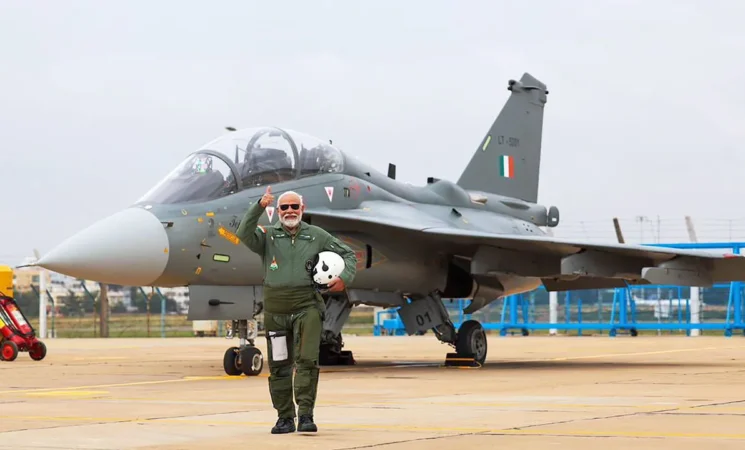12 June 2025, NIICE Commentary 11250
Dr. Prashant Hosur Suhas
India’s approach to defense modernization has been very uneven. It is possible that the reason why India’s defense modernization has been so slow is because India has historically avoided the use of force, instead opting to react diplomatically to terrorist incidents or engage in covert operations. Former Minister of External Affairs, Jaswant Singh once argued that purpose of mobilization during Operation Parakram was to defeat terrorism without conflict and manage the public mood at the time. India displayed a similar approach after the 26/11 Mumbai attacks when the then government chose against visible military actions against terror infrastructure in Pakistan due to perceived unifying effect such attacks would have within Pakistan and a perceived limited utility of such actions. What is more, some had recommended not constructing border roads facing China as a defensive mechanism as the lack of infrastructure would prevent Chinese intrusion into Indian territories. In sum, India had developed a tradition of justifying the non-use of force on “strategic grounds” and passing it off as high-brow intellect. Regardless, such an approach possibly put less pressure on India to pursue defense modernization with a sense of urgency and intent that would be more appropriate for a state facing two nuclear-armed rivals.
The recent India-Pakistan crisis has offered much food for thought for conflict experts worldwide. Here, instead of rehashing the developments of Operation Sindoor, I address a key question of why war-making remains central to state-making. A historical analysis indicates that wars and security rivalries have been drivers of economic development and India’s particularly challenging security environment provides a great opportunity for embarking on purposeful industrialization that can aid India’s military modernization. This piece is divided into two parts. The first part summarizes the broader social science literature that shows how wars and rivalries have been associated with expansions in state capacity. Second, I discuss how recurring conflict such as the Uri surgical strikes, Balakot strikes, and now Operation Sindoor are likely serving as the much-needed motivation for India to take defense modernization seriously, as the use of force no longer remains a “theoretical possibility” but rather a recurring reality.
“War-making and State-making”
Charlies Tilly famously argued that the process of war-making was central to the process of state making. War-making puts pressures on the state to mobilize its resources like no other social phenomenon does. Therefore, to extract and mobilize resources, states develop and maintain strong bureaucratic and security apparatus that allow them to establish monopoly of violence over their territories and extract the resources and mobilize the population in pursuit of its war-making efforts. Others have extended this basic idea to empirically show how major wars tend to cause a permanent shift in defense expenditure patters. While they reduce from their war-time high, they do not return back to their pre-war levels. Others have adjusted this thesis to argue that it is not just wars, but drawn-out security competitions that also exert a similar influence on expansions in state institutions, and subsequently on state capacity and development. It’s been argued that states engaged in security rivalries usually see an increase in their state capacity, be it measured in terms of its tax collection, military expenditures per capita, GDP per capita, or infrastructure development.
For example, The National Aeronautics and Space Administration (NASA) was founded in July 1958, 10 months after the Soviet Union beat America to reaching space by launched Sputnik in October 1957. While the United States was developing space technology prior to this, its efforts were haphazard and lacked intent. President Eisenhower was interested in space program purely as a scientific pursuit while the three military services were pursuing their own missile and rocket programs, owing to inter-services rivalry. The space race with the Soviet Union gave a sense of urgency, focus, and intent to the American program which culminated in the Explorer I launch in January 1958 followed by the establishment of NASA in July 1958.
Operation Sindoor and India’s Defense Modernization
Doctrinal Pressure on Military Capacity
When Prime Minister Modi stated that any future act of terrorism will be viewed as an act of war by Pakistan, it not only marked a departure from India’s past practices, but it also meant that the region is possibly heading into a more volatile period as an act of terror carried out by a few individuals could escalate quickly into a war. However, the new doctrine also places a heavy burden on Indian military capacity as well. If conflict outbreak and escalation become more likely given a lower threshold to trigger crises, then India’s military inventory will have to be battle ready at a rate higher than it was earlier. With the probability of crises escalation higher now, India is under greater pressure to fill its squadron deficit than ever before. What is more, India can now ill afford inordinate procurement delays which have plagued the IAF for decades. Procurement delays and import dependency is likely to affect India’s ability to enforce the new doctrine.
Funding Technology R&D: The Positives
Perhaps the most impressive of India’s achievements during Operation Sindoor has been the deployment of its air defense system that managed to thwart much of Pakistan’s drone attacks and be cost effective at doing that. Israel for instance has also successfully intercepted Hamas and Hezbollah rockets but their interceptors tend to be many times more expensive than the rockets fired at them. Each Tamir interceptor missile costs roughly USD 50,000 while the rockets that it targets costs roughly USD 800. Moreover, it is likely that Israel has to shoot 2 of its Tamir interceptor missiles to take down 1 incoming rocket. Indian air defense systems seem to have found an answer to this economic asymmetry by deploying the Bhargavastra and Indrajaal systems that substantially reduce the cost of intercepting low-cost rockets and drones. The Indrajaal system uses a radar to detect incoming targets and is able to undertake both hard and soft kills by either deploying projectiles that take down incoming targets or disrupts the drone’s GPS signal to divert it away from its target.
The Challenges Ahead
The most visible and pressing challenge for the Indian military continues to be the air force’s squadron strength. While procurements will have to be made in a timely manner there are issues with jet engine development that has plagued the Indian establishment for decades. Lack of experience and expertise, immediacy of engine needs, IPR issues in joint collaborations, and issues of underfunding have all contributed to inordinate delays in the development of the Kaveri jet engine. For instance, India is set to finally get its own engine test bed in October 2025. Historically, India had to take its engine to Russia or the United States for testing. Given that the engine development program dates back to the 1980s, the lack of a test bed in 2025 is emblematic of the delays (possibly owing to lack of prioritization and funding) that has frustrated Indian Air Force’s leadership in recent months. More generally, the idea of “make in India” has strategic relevance. However, given the global nature of supply chains, it is likely that India will depend of these global supply networks for raw materials or specific components (even America’s F-35 jet is reported to have Chinese components). That said, developing its own intellectual property and its own defense products has become a strategic necessity.
Conclusion
In sum, Operation Sindoor provides a trigger that conveys to Indian decision-makers that the use of force is no longer a theoretical possibility, but an option India will likely exercise. Therefore defense modernization must be undertaken on “mission mode” similar to how the United States in the 1950s and 1960s undertook the development of its space and rocket program when it was spooked into space by the Soviets. Wars and rivalries have been empirically shown to cause expansions in state capacity and military capacity around the world, and India should not strive to become the exception to the rule.
Dr. Prashant Hosur Suhas is a Visiting Fellow at NIICE.

